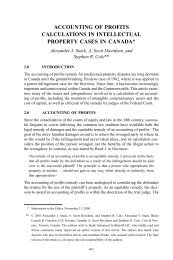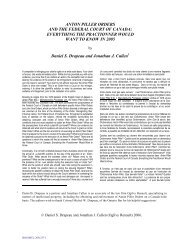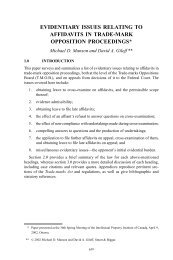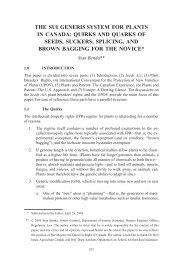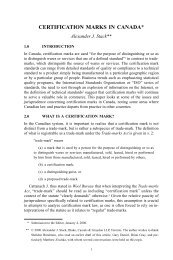A Comparative Overview of Canadian, US and European ...
A Comparative Overview of Canadian, US and European ...
A Comparative Overview of Canadian, US and European ...
Create successful ePaper yourself
Turn your PDF publications into a flip-book with our unique Google optimized e-Paper software.
Grace period<br />
See CETA Article 9.3<br />
where Canada<br />
proposes a 12-month<br />
grace period. No<br />
change to <strong>Canadian</strong> law<br />
would be required if that<br />
proposal were<br />
accepted. Note that the<br />
precise nature <strong>of</strong> the<br />
grace period is not<br />
specified. Presumably a<br />
<strong>Canadian</strong>-style grace<br />
period was intended,<br />
but Art 9.3 would also<br />
be satisfied by a <strong>US</strong><br />
style grace period.<br />
First-to-file/first-toinvent<br />
If an inventor non-confidentially discloses<br />
their invention that disclosure will not be<br />
considered prior art, <strong>and</strong> so will not<br />
“anticipate” the invention, so long as the<br />
inventor files their application within one<br />
year <strong>of</strong> that first disclosure.<br />
Note that the <strong>Canadian</strong> grace period<br />
applies only to <strong>Canadian</strong> applications. If a<br />
<strong>Canadian</strong> inventor publically discloses<br />
their own invention prior to applying for a<br />
patent, the inventor will be able to take<br />
advantage <strong>of</strong> the <strong>Canadian</strong> grace period<br />
by filing a suitable <strong>Canadian</strong> application<br />
within one year, but they will not be able to<br />
obtain a <strong>European</strong> patent.<br />
An inventor is granted a one year grace period<br />
from the first non-confidential disclosure <strong>of</strong> the<br />
invention to file a patent application in the<br />
United States. This is similar to Canada in that<br />
both systems provide that disclosure by the<br />
inventor will not count as prior art if the<br />
inventor subsequently files within the grace<br />
period. However, the new America Invents Act<br />
(AIA) provides that any disclosure <strong>of</strong> the<br />
subject matter <strong>of</strong> that invention during the<br />
grace period will not count as prior art,<br />
including disclosure by independent parties. In<br />
contrast, in Canada, disclosure by a third party<br />
during the grace period will count as prior art.<br />
Note that the <strong>US</strong> grace period applies only to<br />
<strong>US</strong> applications.<br />
There is no general grace period for<br />
disclosures by the inventor, <strong>and</strong> a nonconfidential<br />
disclosure normally raises an<br />
immediate <strong>and</strong> automatic bar to patentability.<br />
There are some very limited grace periods<br />
provided, for example, where there is a breach<br />
<strong>of</strong> confidentiality, but these will be relevant<br />
only in unusual circumstances.<br />
In a first-to-file patent system, if two individuals invent the same invention, the first to file their patent application will be entitled to the patent. In<br />
a first-to-invent system, the patent will be awarded to the individual who first invented the invention, after a special proceeding is held to make<br />
that determination. Almost all countries except the <strong>US</strong> now use a first-to-file rule, <strong>and</strong> the <strong>US</strong> will be adopting the first-to-file rule in March <strong>of</strong><br />
2013.<br />
Public disclosure Public disclosure by others before the<br />
priority date is citable.<br />
Co-pending<br />
applications may be<br />
citable<br />
Inventive step/<br />
Obviousness<br />
Co-pending applications may be citable.<br />
Public disclosure by others before priority date<br />
is citable.<br />
Co-pending applications may be citable.<br />
Public disclosure by others before priority date<br />
is citable.<br />
Co-pending applications may be citable.<br />
All patent systems require that an invention be inventive in order to be patentable. This is intended to ensure that the technical advance<br />
disclosed by the patent is something that deserves the reward <strong>of</strong> a patent monopoly, <strong>and</strong> not a routine advance that would have been arrived<br />
at in any event. In all three jurisdictions, an invention is considered to involve a sufficient inventive step if, having regard to the state <strong>of</strong> the art,<br />
the invention would not have been obvious to a person or ordinary skill in the art.<br />
While this concept is clear <strong>and</strong> well-established in all jurisdictions, it is a st<strong>and</strong>ard which is <strong>of</strong>ten difficult to apply to the facts <strong>of</strong> a particular<br />
case. While there are differences between the jurisdictions in the details <strong>of</strong> how the courts determine whether an invention would have been<br />
obvious to a skilled person, it is not clear whether the inventive step requirement is systematically more or less stringent in any particular<br />
jurisdiction. The uncertainty inherent in the application <strong>of</strong> the test to any set <strong>of</strong> facts makes it difficult to determine if there are systematic<br />
differences. Even when the same patent is held to be obvious in one jurisdiction but not in others, this may be simply because <strong>of</strong> the<br />
uncertainty in the test itself, <strong>and</strong> the way the evidence was weighed by a particular judge, rather than because the legal st<strong>and</strong>ard is<br />
systematically differently applied.<br />
Broadly speaking, the grace period applies in the <strong>US</strong> <strong>and</strong> Canada with respect to obviousness in the same way that it applies with respect to<br />
novelty. However, a pending patent application may not be citable for obviousness as <strong>of</strong> the same date on which it becomes citable for novelty.<br />
This is a brief <strong>and</strong> very simplified summary <strong>of</strong> selected aspects <strong>of</strong> the three patent systems. It is intended for general informational purposes <strong>and</strong> should not be<br />
used as a basis for taking decisions with regards to any specific cases. Qualified advice should be sought regarding any specific fact situations. All references<br />
WSLegal\049190\00037\8068137v1<br />
to CETA are based on our underst<strong>and</strong>ing <strong>of</strong> the provisions <strong>of</strong> CETA, as determined from sources available on the Internet. IPIC ©2012<br />
7/24



